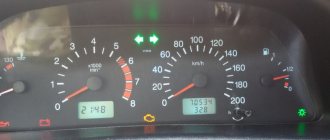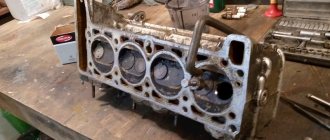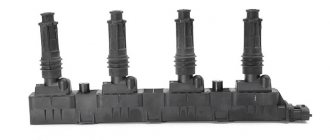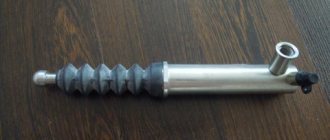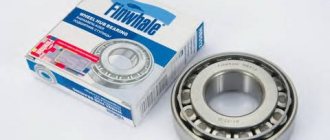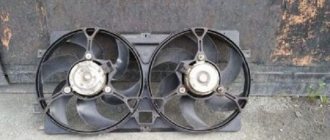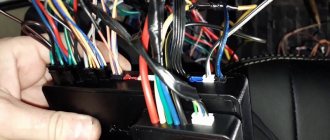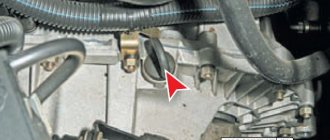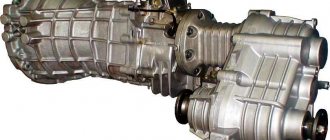The decision to install hydraulic compensators on the Chevrolet Niva freed the owners from the need to adjust the thermal valve clearances every 10-15 thousand km. mileage As a result, the timing belt became quieter, more efficient and more stable.
Motors 21214 were originally equipped with:
- old-style hydraulic compensators (before 2008);
- hydraulic compensators of a new type (since 2008).
In general, Chevrolet Niva hydraulic compensators (hydraulic supports) are quite reliable. However, the use of low-quality motor oil, untimely replacements and a number of other reasons can lead to noise in the timing belt. In this case, the hydraulic compensators need to be cleaned and pumped or replaced. Read more in our article.
Description of the hydraulic compensator device and its principle of operation
Hydraulic compensators are designed to automatically regulate the thermal gap between the valves and the engine camshaft. The hydraulic attachment is provided by oil, which enters the expansion joints under pressure, and a complex and incredibly precise set of springs provides the necessary clearance.
Hydraulic compensators, which have been installed on Chevrolet Niva in recent years, give them a tangible advantage:
- there is no need to periodically adjust the valves;
- now the timing belt works more clearly and correctly;
- The noise when the engine is running has decreased significantly; it begins to knock less;
- The service life of timing parts has increased significantly.
Main details of the unit:
- Plunger pair.
- Frame.
- Plunger bushing.
- Plunger spring.
- Plunger ball valve.
The operating principle of the unit is relatively simple and consists of three main functions:
- There remains a small gap between the camshaft cam and the compensator, which is filled with oil. The plunger spring pushes the plunger out of the sleeve, the oil fills the gap under pressure, reaches the desired level, and the ball valve shuts off the oil supply. After these actions, the gap disappears.
- By turning, the cam moves the compensator down. Due to the accumulated oil, the plunger pair becomes rigid and presses on the valve, opening it.
- As the plunger moves down, it loses some oil and its pressure drops. As the cam moves further, the cycle repeats.
Device
The operating principle of this unit is that the mechanism can automatically change its length by an amount equal to the clearance in the valves. The movement of the component elements in the assembly is carried out due to springs and oil, which comes from the car’s lubrication system. Let's see how the hydraulic compensator works. We already know what it is. So, a compensator is a housing in which a plunger pair is installed. She can move. In turn, this part consists of several elements:
Cylindrical pushers, parts in the cylinder head, and levers in the drive can be used as a housing for the hydraulic pusher.
There is a hole at the bottom of the plunger that is closed by a ball valve. The operation of the hydraulic compensator is possible due to the spring located between the plunger and the bushing. Almost all elements are arranged this way. VAZ hydraulic compensators are no exception (Priora 2172 is also equipped with them).
How to identify a faulty hydraulic compensator
To determine a knocking compensator, you need to use a screwdriver, which is used as a lever, to press on those “hydraulics” that are at TDC (top dead center). If the hydraulic compensator fails under pressure from a screwdriver, it means it is not adjusted. If you want to make sure of this, quickly press with a screwdriver and you will hear a characteristic sound.
Typical faults
Problems with hydraulic compensators arise for two reasons. It is not difficult to identify them - this is either a mechanical breakdown of the unit itself, its destruction, or a breakdown of the oil supply system to the compensator.
In the first case, a common cause is wear of the plunger pair. This is an inevitable process that depends only on the operating time of the unit and the quality of the metal from which it is made. Factory defects cannot be ruled out; this is extremely rare, but it does happen. Replacing this part costs the same as replacing a regular consumable.
In the second case, the oil level in the engine matters; it can be too low or too high. The oil filter may be dirty and dirt may have entered the channels. Untimely oil change is another reason for unstable operation of the unit.
Do not forget about the correct selection of oil - use oils of the same type and preferably from the same manufacturer. The consequences of failure to comply with these rules can be disastrous; saving on oil can cost you money to repair the engine.
About the design of gas distribution mechanisms
In a simple case, the compensator is an extension of the valve heel. More precisely, the hydraulic compensator is mounted on the valve and transmits the force received from the cam. This diagram is clearly shown in the figure:
Here the compensator comes into contact with the cam
What is considered is one of the options. But there is another one, when the cam presses on the rocker arm. The rocker itself is pushed up by two different elements. On one side it will be a valve, on the other - a hydraulic compensator. The first of them moves, the second remains at the same level:
The compensator presses on the rocker from below
If the compensator is faulty, a gap will appear between the cam and the rocker arm.
Note that the lever rocker arm of the valve was not discussed above. The diagram with a lever rocker is shown below. The compensator looks different there than in cases “1” and “2”.
Previously, the timing design used a single camshaft (SOHC), and the force to the valve heels was transmitted through a lever. In order to eliminate the gap, the lever was equipped with an adjusting screw 5. It was fixed with a lock nut 6:
Timing diagram with lever rocker arms
The mechanism discussed above can be equipped with hydraulic compensators. Their device is shown in Figure “b”:
Schemes “a” and “c” correspond to the first and second cases. There shouldn't be any questions here.
Externally, the design of compensators may vary, but the principle of operation will always be the same. The main design elements are the following parts: check valve (ball), plunger spring 5 and valve spring 6. Number 3 indicates the plunger sleeve, and part 2 is the plunger.
Note that hydraulic compensators are not used in the design of the 4A-FE and 5A-FE (Toyota) engines. They are available in motors of the following series: 2S, 1NR, ZR, TR, 5M.
Causes of knocking hydraulic compensators
The knocking sound of Chevrolet Niva hydraulic compensators can be easily detected by ear; it knocks at a frequency half the engine speed. It can knock both on a cold engine and on a hot one, and the reasons for this are different.
Reasons for knocking when cold:
- Thick oil. As the engine warms up, the oil heats up, becomes thinner, and the knocking noise goes away.
- Dirt. A bad filter or old oil can cause dirt to get into the channels and holes and clog them.
- Worn or broken plunger. The cause may be natural wear or abrasive contaminants that have entered the oil.
"Hot":
- Plunger jamming. Scuffing on the plunger pair increases its wear significantly and blocks it.
- Oil with incorrect viscosity. When changing the oil seasonally on their own, sometimes owners make mistakes and fill in oil with the wrong viscosity. If it is too liquid, it quickly flows out through those. gaps.
- Increased oil level in the engine. If this is due to coolant getting into the oil, it will foam in contact with the crankshaft.
All these reasons can be eliminated yourself if you carefully monitor your car.
Recommendations
- It should be noted that not in all cases Niva hydraulic compensators need to be replaced. The fact is that often their thin channels simply become dirty, as a result of which the valve mechanism begins to knock heavily. For this reason, you can wash old hydraulic mounts in gasoline.
- Also, upon inspection, it often turns out that only one Niva Chevrolet hydraulic compensator makes a knocking noise. This means that replacing the entire set is not required. In this case, all hydraulic supports are also washed, and only one faulty Niva hydraulic compensator is replaced.
We also recommend reading the article on how to flush hydraulic compensators without removing the motor. From this article you will learn about the available methods for washing HA, as well as what subtleties and nuances need to be taken into account as part of this procedure.When replacing hydraulic valves or other work, it is important to know how to bleed hydraulic compensators. There are two methods: automatic pumping of hydraulic compensators and manual pumping. In the first case, the engine starts, the speed needs to be raised to 2-3 thousand and wait 3-4 minutes, then 30 seconds. the engine should run at idle. Then the engine must be turned off for 60 seconds. and start it again. If there is no knock, the hydraulic compensators are pumped. If the knocking noise remains, the procedure should be repeated 2-3 times.
- Manual bleeding of hydraulic compensators is performed when the elements are removed from the engine. If Niva hydraulic compensators are being replaced in order to pump the hydraulic fluid, they are placed in a container with oil with the plunger facing up. The oil level in the container should be near the line of the middle cut of the compensator. Next, you need to press the compensator plunger with your finger. If dirty oil begins to come out through the valve, you need to pump until clean lubricant comes out.
- After replacing the hydraulic fluid in the engine, it is recommended to change the engine oil and accurately check its level. Even a slight lack of lubrication will lead to insufficient oil pressure for the hydraulic compensator, and the hydraulic compensator will become airy and knock. For this reason, the oil level must be constantly monitored.
Is it worth replacing hydraulic lifters with bolts on a Chevrolet Niva
What is more practical, a bolt or a hydraulic compensator - this question worries many Chevrolet Niva owners. First you need to find out why some drivers decide to make such a replacement? The answer is simple - the introduction of compensators gave hope to once and for all solve the issue with thermal gaps. In fact, the poor quality of hydraulic compensators only worsened the situation - more money was spent, but the problem was not solved.
For this reason, some Niva-Chevrolet owners “return to basics,” i.e., they switch back to bolts. One can argue a lot about the effectiveness of such a transition, but often on the forums of owners of such cars one can read the following reviews:
“...I changed the hydraulics back to bolts, the result: the consumption dropped, the idle speed was stable, the traction started from the bottom, the clutch became noticeably lighter. I’m happy with the decision, the replacement justified itself.”
Installation
Several times they sent me links from forums about the fact that they installed German hydraulic compensators, but it became little better than it was. The issue is not with the INA hydraulic compensators, but with the cups. If you look at how the hydraulic compensators are installed in the cylinder head, you will see that the vector of application of force by the camshaft cam goes vertically, and the hydraulic valves and cups are at an angle to the vertical. The cups are traditionally made from shit of poor “half-baked” material, so after a while (50-70 thousand km) an elliptical groove begins to appear, along which the oil pressure required for the hydraulics begins to disappear. Therefore, if you want to update the system and install German hydraulic compensators, install new glasses.
A series of articles devoted to hydraulic compensators and bolts:
Part 1. Hydraulic compensators, review article
When it is necessary and when it is not necessary to change hydraulic compensators and replacement features
Ideally, during normal operation of the hydraulic compensator there should be no extraneous sounds. But sometimes you hear sounds from under the hood that make you want to replace timing parts. But hydraulic valves on engines with high mileage must be replaced - they have a high percentage of wear and tear and there is no point in repairing them. In other cases, you can get by with less radical actions.
Attention. Sometimes you shouldn’t immediately disassemble the engine and try to find out the cause of the breakdown. Often an oil change is enough for the problem to go away, and money and nerves are saved.
Among the features of replacing hydraulic compensators on a Chevrolet Niva, it is worth highlighting the following:
- if you notice an extraneous knock from under the valve cover, do not rush to immediately disassemble the timing belt and change components; first change the oil and filter;
- use oil from the same manufacturer;
- there is no need to tighten the parts too much, this may lead to breakage;
- When installing new parts, do not forget to rinse them thoroughly in gasoline.
This is interesting: Step-by-step instructions for replacing the cylinder head gasket in a Niva Chevrolet
Features of replacing the timing chain in a Chevrolet Niva with your own hands
Do-it-yourself Chevrolet Niva valve adjustment
Hydraulic compensator 21214, a little theory
Let us take the following as an axiom - all mechanical parts wear out. Let's try to figure out why these hydraulic compensators on BMW engines last up to 150-200 thousand, but on this engine the real mileage is about 70 thousand. Further, the engine already resembles a machine gun firing blank cartridges. I already said in the first chapter that the hydraulic compensator is a hydraulic cylinder, and they obey the laws of hydraulics. So, the eternal Russian question: who is to blame for such a short period of normal work?
System health check
After all the parts are already installed, clean the valve cover from dirt, dust and oil leaks. Using a small brush, remove the remaining sealant and old gasket from both surfaces of the base; this can also be done with the back of a penknife. We apply sealant to the perimeter of the supporting cover and install the purchased gasket, making sure that it does not extend beyond the edges of the upholstery. We apply exactly the same layer on the opposite surface and fix it with light pressure. If you still have questions about repairs, you can watch a video on replacing hydraulic compensators in two parts.
Video: How to change hydraulic compensators on a Chevrolet Niva with your own hands
Now, when driving, the knocking in the car should completely stop, but if this does not happen and you hear an annoying sound, then you should contact the nearest car service center for a full diagnosis and subsequent repairs.
Adjusting bolt or HA
Even at low mileage, this knocking noise may appear, this is because low-quality compensators are initially installed on the Chevrolet Niva from the factory, and the cause may also be insufficient tightening of the main valve at the factory, but if the hydraulics are still inoperative, then they can be replaced, for example, with those which are produced by the German company INA, they are one of the most reliable, you can also purchase derivatives for this car at AvtoVAZ, they come in two samples, old and new, and differ in cylinder heads.
Basically, they are sold individually, but their price is not cheap, ranging from three hundred to four hundred rubles, but the adjusting bolt will cost half as much. If the adjustment occurs every ten thousand kilometers, then it will be more convenient to install an adjusting bolt, since there will be fewer problems and it will be cheaper.
Recommendations
Comments 54
1. How to hear which main engine is knocking. A stethoscope, which is what I use (a small box with a metal rod and a capsule in the ear). If it is not there, then a wooden ruler in the teeth (but audibility is worse and you need to plug your ears). You can try it with a medical stethoscope with the appropriate attachment (I haven’t tried it, because there is no need) 2. What year is the car made? If up to 2008 inclusive, then the hydraulic locks are of the old type and they need to be tightened to a torque of up to 2.5 kgf, preferably 1.8-2 kgf, otherwise it will be worse than it was. And for this you need a torque wrench. Moreover, the entire operation of replacing the camshaft housing (except for the first one, it cannot be removed due to the tide on the camshaft housing) can be performed without removing the camshaft housing, just unscrew the nuts securing the housing and lift it as much as possible (as far as the chain will allow). To determine the tightening force, clamp the square of the dynamic key into a yew, and place a 27 wrench on top of it (if I’m not mistaken). The key will be shorter than the din. key. Take your hand at the place where the force is applied to the simple key and begin to “tighten” while holding both keys with your hand, looking at the readings of the dynamic key up to 2 kgf. This is how you determined the tightening force using a simple wrench. Well, go ahead. GKs cost approximately 250-350 rubles, do not forget to buy a pair of studs (long and short) in case the threads on the existing studs are bad. Tighten the camshaft housing according to the diagram and din. key, otherwise you will break the pins. Well, look at the supply line that was recommended in the posts above. There may actually be a crack or leak. I've done the same thing myself more than once. The result is 100%. I DO NOT recommend doing repairs without a torque wrench. Good luck. If you don’t understand anything, write and I’ll answer.
Thank you very much, but everything has already been changed! For those who will change the Civil Code, this information will really help!
I'm very glad that I helped in some way.
Why do you think that the compensators are knocking, maybe it’s a matter of the tensioner
The compinastors were whole, the workers turned out the rack had burst) they were all thrown out and plates were installed
Car 2003 The first set of hydraulics ran for 150,000, although the “pilot” set it to 80,000. Now the second set works without problems. Shell Helix Ultra oil after 15000. There is no desire to install bolts.
They knock the same thing when cold and I will only change it to a hydrocom and not toy soldiers
here is the specific link of the specialist niva-fr.ru/?page_ >
Everything has already been done) the conpinsators were thrown out and plates were installed instead. But thanks anyway)
Is it possible to replace the Hz with bolts yourself? who has info
We changed it ourselves without any specialists, etc., just take care of your nerves, it’s difficult to get there, but it’s still possible! I just called a friend at the end to adjust the gap; he had already adjusted it more than once, but you can do it yourself
I support normal synthetics and no problems with hydraulics. The knocking noise can only be due to oil starvation or a broken spring in the hydraulic valve; as a rule, it can be treated by disassembling and cleaning the compensator. In any case, it is worth replacing only a faulty one with a broken spring or obvious signs of wear and external defects in the form of cavities, etc.
I am for! hydraulics. So far everything is working fine for me! A knocking sound when cold may be due to oil. for them it is desirable ONLY SYNTHETICS! tap on the mineral and half-blue. there have already been discussions on the drive!
Take them away and drive on a simple head, there was an ambush with them, I suffered, changed them to a regular one and forgot about everything!
Tips for replacing Chevrolet Niva hydraulic compensators
- If the hydraulic compensators are knocking on a Chevy Niva, you should not immediately rush to remove the valve cover - first you need to try replacing the engine oil in the engine.
- The engine should be filled with high-quality synthetic oil that complies with the SAE classification - 10W40 “synthetic” is suitable for summer; in winter it is better to use less viscous oil, for example, 5W40 or 0W30. If the oil is changed every 10 thousand km, and the oil is of high quality, then the likelihood of clogging the hydraulic compensators is not so great. Another tip is to fill in the same brand of engine oil.
- Old-style hydraulic compensators should not be over-tightened - overtightening will quickly cause them to fail. The force used is about 2 kgf, but if they are tightened too loosely, they can unwind.
- Before changing the HAs, you can first try rinsing them. Hydraulic compensators are washed in gasoline; for high-quality cleaning of toxins, the hydraulic compensators must be disassembled. After cleaning and assembly, the compensators should be checked: you need to push the plunger in with your fingers - if the hydraulic valve is in good condition, it should return back to its original position.
Russian NIVA Chevrolet SUVs were initially produced with two engine options: VAZ-2123 with a volume of 1.7 liters, Z18XE from the auto industry with German Opel quality, the volume of which is 1.8 liters. If the car has a modified German engine, then you should not expect any failures from it. With the Russian assembly, things are more complicated, since, according to reviews from car owners, knocking occurs over time, the engine begins to work intermittently, which leads to premature replacement of hydraulic compensators. If you hear a knocking sound from the valves, experienced auto mechanics recommend first replacing the engine oil and oil filter.
Hydraulic compensator 21214, specifics
In 2013, I ordered a batch of hydraulic compensators in Germany from the trendsetter in this area, the German brand INA. I won’t talk for a long time about their quality; they are a supplier of “German troika” conveyors. The first thing I did, like a true young man, was to take the hydraulic valve out of the “factory engine,” put it next to the “German” and pick up a micrometer. The first difference was purely visual. This is clearly visible in the photo. This is the ball shape and the height of the compression skirt. But that was only the beginning. Everything is like in a Russian fairy tale. The further you go, the worse it gets. The diameter of the factory miracle is 0.03 mm less. That is, there is simply no need to talk about maintaining the working pressure in the cup-hydric pair. Any hydraulic engineer, or just a mechanical engineer, will tell you that this is an unacceptable gap for hot oil. Result: inability to compress the valve spring and incomplete opening of the valve.
diameter of hydraulics
